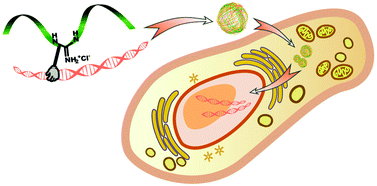Design and synthesis of a polyguanidium vector with enhanced DNA binding ability for effective gene delivery at a low N/P ratio†
Abstract
Synthetic cationic polymers are commonly used vectors for non-viral gene delivery. However, the transfection efficiencies of such vectors are inevitably linked to their cytotoxicity, because the positive charge density of the polymers is the decisive factor of both. High charge density is necessary for gene condensation and intracellular internalization, while it also leads to undesired toxicity mainly due to membrane disruption. To address this problem, in this work, we introduced a new DNA binding driving force into the polymeric vector, using a guanidium-on-backbone polymer to facilitate efficient gene condensation. In addition to electrostatic interactions, polyguanidium provided extra affinity toward DNA by serving as a multivalent minor groove binder. It was shown that this polymer could tightly condense genes at relatively low charge ratios using an N/P ratio as low as 2.5 : 1 and give a gene transfection efficiency comparable to the commercially available reagent, 25 kDa polyethyleneimine. Such polymers also exhibited relatively low toxicity, benefited from their lower positive charge density.



 Please wait while we load your content...
Please wait while we load your content...